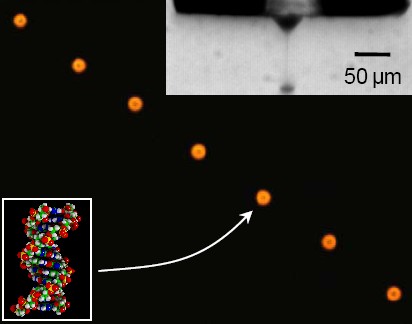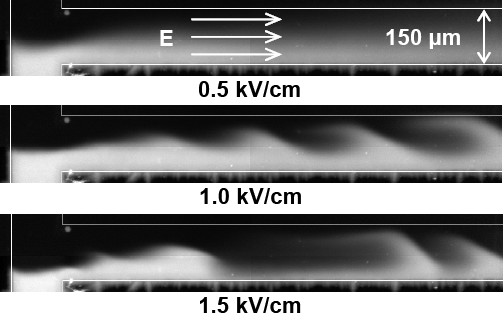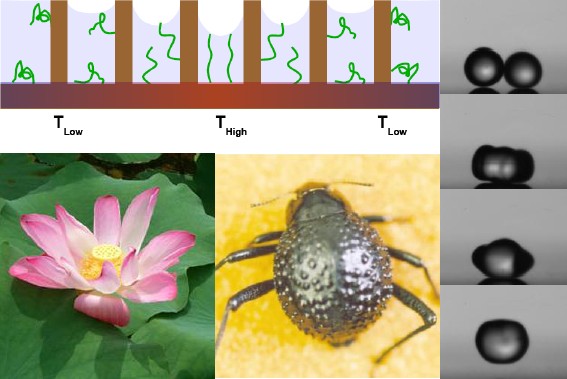|
Home | News | People | Research | Teaching | Publications | Links | Openings Overview of µPHYL Research Our research involves physicochemical hydrodynamics at the micro and nanoscale where transport and interfacial phenomena closely interact with each other. Two core subjects are electrohydrodynamic transport for fluid manipulation at both nanometer and nanosecond scales, and bioinspired interfaces for capillarity-driven autonomous microsystems. We are closely integrating experiment and theory to develop these interdisciplinary fields for innovative applications ranging from biochemical assays to nano-instrumentation, and from microelectronics cooling to water management. Electrohydrodynamic Transport: Toward Nanoscale Resolution Micro and nanofluidics is particularly important for biomedical applications involving liquid manipulation. Electrohydrodynamics is essential as electric fields offer exquisite control of liquid streams. We will develop electrohydrodynamic systems toward nanometer and nanosecond resolution. Electrohydrodynamic cone-jet transition is a unique technique to produce micro to nanoscale jets from a millimetric nozzle (Figure 1 inset), and is instrumental to widely used techniques such as electrospraying and electrospinning. Our research efforts focus on modeling the cone-jet transition and using the cone-jet to deploy tiny droplets and nanoscale objects. We identified an intrinsic pulsation process of the cone-jets which governs the electrohydrodynamic drop-and-place process, and developed an analytical model for the kilo-Hertz pulsations. Guided by this model, we are using the cone-jets to deploy nanoparticles and biomolecules with sub-micron positioning accuracy (Figure 1) and single-particle dosing accuracy. A successful demonstration of the single molecule (particle) drop-and-place system will present enormous opportunities for molecular biologists and nanotechnologists.
Figure 1. Electrohydrodynamic drop-and-place Electrokinetics is the most adopted transport mechanism in lab-on-a-chip devices. Electrokinetic flow instabilities (Figure 2) have been reported since the late 90s as a bottleneck to reproducibly assaying heterogeneous samples. Through integrated experimental, analytical and numerical work, we identified conductivity gradient and associated charge accumulation as the origin of electrokinetic instabilities. We further developed controlling parameters for the onset of convective and absolute instabilities, guiding engineering designs to suppress (in assays) or enhance (in mixers) such instabilities. Currently we are using these guidelines to develop electrokinetic assays capable of extracting nanosecond reaction kinetics. We are also interested in extending the concept of convective and absolute instabilities to other electrohydrodynamic systems (e.g. electrospraying) and to biological processes (e.g. cellular signaling).
Figure 2. Electrokinetic flow instability Bioinspired Interfaces: Toward Autonomous Microsystems Nature is an endless source of inspirations for nano-engineered systems. We are interested in nature's interfaces such as self-cleaning lotus leaf and water-harvesting beetle shell. These bioinspired interfaces are particularly suited for the R&D trend toward autonomous microsystems. Superhydrophobicity has wide-ranging applications including self-cleaning materials, drag reduction, and water management. Lotus leaves are water-repellent owing to its rough surface with a two-tier texture, which stably traps air beneath water drops and makes the leaf superhydrophobic. We have developed a lotus-mimicking two-tier surface with carbon nanotubes deposited on micromachined silicon posts (Figure 3). The engineered texture even surpasses lotus leaves in terms of sustaining superhydrophobicity during and after condensation. We are currently investigating the fundamental physics behind superhydrophobicity. For example, what is the physical mechanism of the two-tier design which water-repellent leaves acquired through evolution? How to switch between the desirable Cassie state where liquid drops sit on top of the texture and the undesirable Wenzel state where drops penetrate into the texture?
Figure 3. Nanoengineered superhydrophobic surfaces The management and conservation of water and energy is of utmost importance to worldwide sustainable development. We propose to meet these challenges by developing bioinspired systems using micro and nanoengineering tools (Figure 4). Lotus-mimicking superhydrophobic surfaces as discussed above can be used to promote dropwise condensation and enhance heat transport in microelectronics cooling. Beetle-mimicking interfaces with alternating hydrophobic/hydrophilic patterns can be used to passively remove water byproducts and improve the efficiency of fuel cells. Other examples include autonomous harvesting of airborne water and adaptive heat spreader in 3D microsystems. The development of these bioinspired systems will be supported by the investigation of fundamental physics behind natural systems.
Figure 4. Bioinspired water management in energy systems Summary The proposed research is rooted in the scientific understanding of transport and interfacial phenomena at small scales, and targeted at engineering applications in the context of bimolecular analysis and water/energy management. Our research philosophy can be summarized by two quotes: Science is nothing without generalizations. Detached and ill-assorted facts are only raw material, and in the absence of a theoretical solvent, have but little nutritive value. -- Lord Rayleigh Whenever an experimentalist finds a nice new effect, theorists move in and after a short time the experimentalists can no longer understand what he did. Then it is time to move to a new field. -- Hans Frauenfelder Mail: 178 Hudson Hall, Box 90300, Durham, NC 27708-0300 | Tel: 919-660-5343 | Email: chuanhua.chen@duke.edu Department of Mechanical Engineering and Materials Science | Pratt School of Engineering | Duke University |










